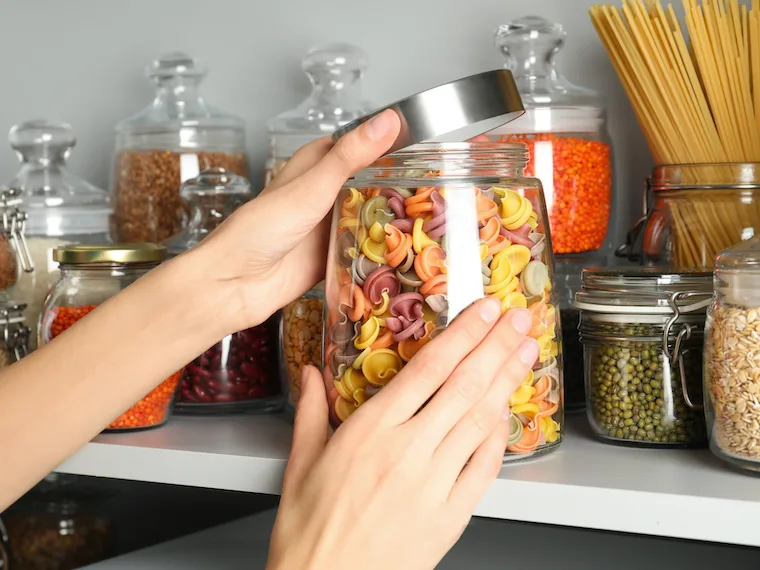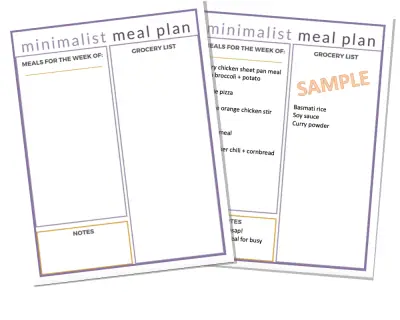Cooking from your pantry can help you save money and time while reducing food waste.
Do you get overwhelmed when you open your pantry?
Are there so many boxes, cans, spices, and pantry staples that you give up and either run to the store for more meal ingredients or eat out?
You’re not alone!
Recent reports indicate that Canadians have returned to their pre-pandemic eating-out spending of $231 monthly or $2,780 yearly.
Go a little south, and the average American spent $300 a month or $3,639 yearly eating food away from home in 2022.
Maintaining a strategically stocked pantry without excess food will save money by reducing food waste. Plus, you have more control over your food to accommodate preferences or allergies.
Keep reading to learn how to cook balanced and filling meals from your pantry.

This page contains affiliate links which means I may earn a commission if you use them, at no additional cost to you. See disclosure policy for details.
Benefits of Cooking From Your Pantry
Cooking from your pantry provides several benefits:
- Reduces food costs
- Helps you pare down to a frugal, minimalist pantry
- Inspires simple, balanced, and filling meals
Reduces Food Costs
It’s much cheaper to make a meal at home than eating out. Most often, a $15 meal from a restaurant can be made at home for about $5.
At a restaurant, you pay for labor, the building, food costs, and for the restaurant to make a profit.
Eating at restaurants can be enjoyable and a regular part of your life, but if you find yourself eating out due to convenience or lack of planning, cooking from your pantry can help you save money.
Food prices away from home have increased by 5.4%, whereas grocery prices have increased at a slower rate of 2.1% in 2023.
In 2022, grocery prices increased drastically by 10%, but over 2023, price increases have slowed and are expected to stay around 2% throughout 2024.
Saving at least $10 per person every time you would normally eat out can add up quickly!
Helps you Pare Down to a Frugal Minimalist Pantry
A frugal minimalist pantry includes dry goods, pantry basics, and staples. It does not include fresh, refrigerated, or frozen foods you likely keep on hand. The key items in a frugal minimalist pantry are inexpensive and versatile.
Learn more about stocking a frugal minimalist pantry and a free printable checklist to get you started.
At the start of creating a frugal minimalist pantry, you will likely need to simplify your pantry. Look over the checklist, remove the excess items, and place them in a container or separate place in your home.
A pantry purge challenge can help with this!
You can cook meals from these pantry items over the next few weeks to reduce food waste and costs.
In America, about 40% of edible food is thrown away. Canadian households are estimated to toss 47% of their food. Yikes!
Cooking from your pantry excess is a great way to reduce clutter. Donate some or all of the unopened pantry items if you want a fresh start.
Simplify to a frugal minimalist pantry to reduce decision fatigue and food waste while saving time and money!
Inspires Simple, Balanced, and Filling Meals
When strategically stocking your pantry, planning and cooking meals becomes easier.
A filling meal doesn’t have to be complicated. Well-balanced meals help your brain work optimally, maintain energy and mood levels, prevent and manage health conditions, and fuel your body well.
Simple Steps For a Balanced Pantry Meal
Use this simple equation to plan a balanced meal:
Protein + Carbohydrates (with fiber) + Fat = Balanced Meal
Try choosing a mixture of macronutrient sources and fiber to create a simple meal from your pantry.
We need macronutrients in larger (or “macro”) amounts to provide our bodies with energy. Protein, carbohydrates, and fat are macronutrients.
Pantry List Categorized By Macronutrient Source
The table indicates if they are a high or medium source of protein, carbohydrates, fiber, or fat. Many of these pantry items contain more than one macronutrient.
Mixed macronutrient foods are versatile as a pantry staple and nutritionally.
For example, beans can work triple duty! They are high in protein, carbohydrates, and fiber.
Pair beans with a carbohydrate source like rice, quinoa, or barley for a balanced meal. Using olive oil to prepare this meal will provide a fat source and add some flavor.
You can pair pantry items with fresh, refrigerator, or frozen items to balance the meal. Find some examples of fresh and pantry foods that are anti-inflammatory here.
See the second table for help determining which item contains which macronutrient.
| Pantry Item | Protein | Carbohydrates | Fiber | Fat |
| Seeds or Nuts | High | Medium | High | High |
| Canned fish: salmon, tuna, mackerel, sardines | High | High | ||
| Nut butter (peanut) | High | Medium | High | High |
| Trail mix | High | Medium | High | High |
| Oats | Medium | High | High | |
| White or brown rice | High | Medium to Low | ||
| Quinoa, barley, couscous or bulgur | Medium | High | Medium to High | |
| Breakfast cereal | Medium to High | High | Medium to High | |
| Crackers | High | Medium | ||
| Popcorn kernels | Medium | High | ||
| Pasta (spaghetti, penne, lasagna) | Medium | High | Medium to High | |
Canned kidney beans, chickpeas, black beans, lentils | High | High | High | |
Dried red or green lentils, split peas, chickpeas | High | High | High | |
| Cornmeal | Medium | High | Medium | |
| Baking supplies: whole wheat or all-purpose flour | Medium to Low | High | Medium in whole wheat flour | |
| Canned tomatoes and tomato sauce | High | High | ||
| Canned vegetables | Medium | High | ||
| Canned fruit (peaches, pears, applesauce) | High | High | ||
| Dried fruit: raisins, dates, or craisins | High | High | ||
| Oils: olive, avocado, canola, sunflower, sesame or garlic | High | |||
| Coconut milk | High | |||
| Powdered milk | High | High |
*Other pantry items like spices, herbs, vanilla extract, vinegar, cocoa powder, chocolate products, and sugar either contribute minimally to each macronutrient or add flavor and enjoyment to the meal.
Most pantry items have a long shelf life of six to twelve months or longer. Consider replenishing them when they get close to a quarter full or run out.
| Fresh, Refrigerator, or Freezer Item | Protein | Carbohydrates | Fiber | Fat |
| Milk and dairy products(yogurt, cheese, dairy alternatives) | High | Medium to High | Low to Medium | |
| Fruits | High | High | ||
| Vegetables | High | High | ||
| Eggs | High | Medium | ||
| Meat, poultry, seafood, and plant protein | High | Medium | ||
| Bread | Medium to Low | High | Medium to High |
Minimalist Recipes
Cooking from a minimalist pantry works best with minimalist recipes.
Minimalist recipes have ten ingredients or less and take about five steps. The ingredients will also be simple, prioritizing less processed, whole foods.
Choosing uncomplicated everyday recipes is more realistic and manageable. Cooking from a pantry is possible when you stock it appropriately, and it is reflective of your eating style.
Often, after getting used to cooking using minimalist recipes, you will no longer even need a recipe at all because they are simple to follow. They lend well to creating your meal from your pantry. You can easily substitute a recipe ingredient with a pantry item with a similar macronutrient mix.
For example, a recipe may call for a cup of dairy milk but you could substitute powdered milk or canned coconut milk instead.
The more you cook from your pantry using minimalist ingredients, the more you will gain confidence in cooking your meals without a recipe.
Additionally, look at your pantry (or pantry excess) and plan meals specifically for ingredients that need to be used. Use keywords such as “simple oatmeal recipes” or “one pot pasta dinner” when searching for a recipe to find ones that use the pantry items you want to use up.
Some people use a “cook from your pantry challenge” periodically to ensure food is not wasted based on the expiration date or items sitting in their pantry for a while.
Takeaways
As you adopt a minimalist, frugal mindset for cooking, use the table above to help you cook filling and balanced meals from your pantry ingredients.
Try to include a protein, carbohydrate with fiber, and a fat source from your pantry to cook simple and affordable meals.
Minimalist cooking from your pantry simplifies life and reduces food costs and waste.
Making your pantry and everyday meals simpler can free up your energy and resources for people and activities that are important to you.
Author Bio:
Sarah Bullard is a registered dietitian at Unstuck Nutrition with 15 years of experience. She currently writes nutrition articles and consults for pediatric clinical research trials and is raising her three boys alongside her husband in East Texas.
Her specialty is helping people make realistic and effective nutrition changes. It can be overwhelming to navigate nutrition and food information and make changes that actually work in your day-to-day routine.
You may also like:
Minimalist Pantry Labels (Cute & Organized!)
An Honest Goodfood Review – Canadian Meal Kit & Grocery Company


